«Reactor Compartments »
During the dismantling process, the bow and stern sections of a nuclear submarine are disposed of as scrap metal and non-radioactive waste. The middle section containing nuclear reactors cannot be dismantled immediately because of residual radioactivity, which remains high even after removing spent nuclear fuel. The Reactor Compartments must therefore be stored for a long time (about 70 years) until the radioactivity decays to a safe level for disposal. The size of a Reactor Compartment varies depending on the type of nuclear submarine. For Victor-class submarines, the Reactor Compartment is about 10 meters in diameter, 10 meters long, and about 900 tons in weight.
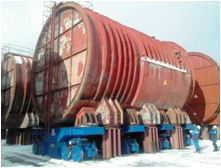 |
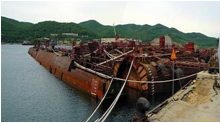 |
| Reactor Compartment | Reactor Compartments stored afloat |
«From Waterborne Storage to Onshore Storage»
Conventionally, the Reactor Compartments have been water-sealed along with the adjacent buoyancy compartments, and kept in the waterborne storage as a ”three-Reactor Compartment Unit (hereinafter “3-RCU”)” ( about three times the length and 1.5 to twice the weight of a single compartment). However, long-term waterborne storage is susceptible to sea water corrosion and maritime weather conditions. To ensure the safe and stable storage of the Reactor Compartments, the Russian government started studying the construction of onshore storage facilities in North West Russia and the Far East around 2000. In North West Russia, the nuclear legacy issues were a matter of serious concern for western European nations. The construction of the onshore storage facility at Saida Bay, the North West Russia, began in 2003 with the assistance of Germany and started its operation in 2006. On the other hand, the construction of a similar facility in the Russian Far East was delayed for various reasons.
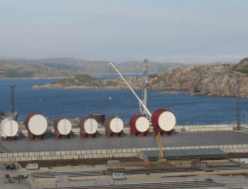 |
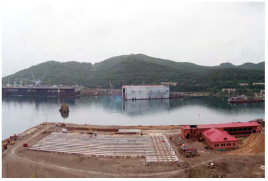 |
| The onshore storage facility at Saida Bay started into operation in 2006 (left). Progress at Razboynik bay at the same time(right). | |
«Japan’s Assistance to the Long-Term Storage Facility»
In the onshore storage facility, safe lifting of the “3-RCU” from the sea to the shore pad of the facility is crucial. Moreover, careful works are required to form a single compartment unit after cutting off the buoyancy compartments. Due to the importance of the onshore storage facility being constructed at Razboynik Bay, the Government of Japan decided in January 2007 to provide three types of key equipment, namely a floating dock, a tug boat, and two jib cranes. After the basic design of the equipment was completed, the Implementing Arrangement was signed with the State Atomic Energy Corporation of Russia ”Rosatom” during Russian Prime Minister Vladimir Putin’s visit to Japan in May 2009, and the Project started. Despite the difficulties in the procurement schedule caused by the Great East Japan Earthquake, all the equipment was handed over to the Federal State Unitary Enterprise “RosRAO” on time by May 2012 (total cost : approx. 4.5 billion JPY). For specifications of the equipment (see here).
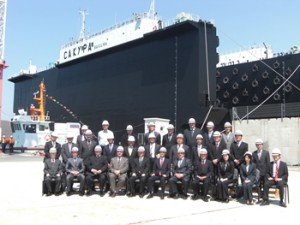 |
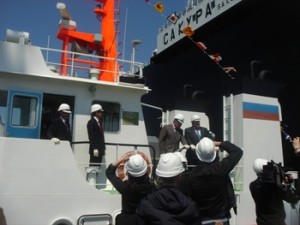 |
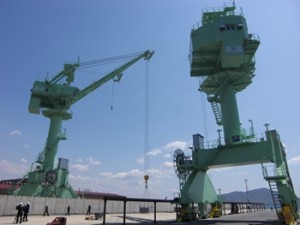 |
| Completion ceremony(May 2012) | ||
«Placing “3-RCUs” Onshore»
On September 24, 2012, RosRAO placed the first “3-RCU” onshore safely, using the donated floating dock. Japan’s cooperation in this regard was highly appreciated at the CEG meeting (see here) held in October 2012 as a milestone achievement toward solving the nuclear legacy issues in the Russian Far East.
Since then, RosRAO (FEO since April, 2020) has continued steadily, with accumulating experiences and skills, to place onshore “3-RCUs” remained in waterborne storage in the Russian Far East, and about 70 units of “3-RCUs” had been landed by the end of 2020.
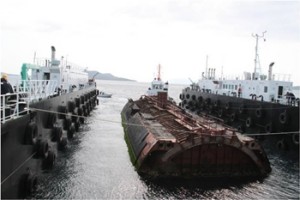 |
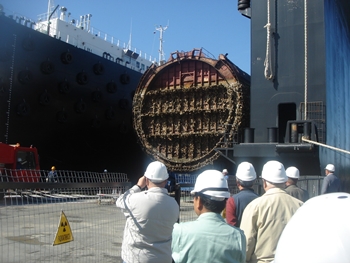 |
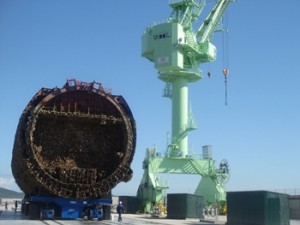 |
| Reactor Compartment, landing operation | ||
«Assistance in Construction of the Blast and Paint Facility»
In response to a request from the Russian Government, the Japanese Government extended additional assistance for the long-term storage facility to construct the Blast and Paint Facility for surface preparation and anti-corrosion painting of Reactor Compartments, which are essential for long-term storage (total cost: 726 million JPY).
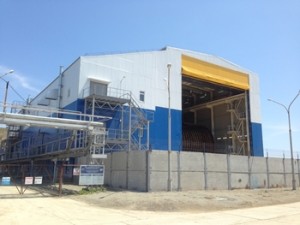 |
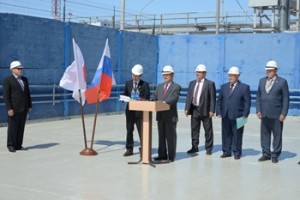 |
| The Blast and Paint Facility | Inauguration Ceremony |
The construction of the Facility was completed in April 2014. In August of the same year, the first Reactor Compartment was blasted, painted and then placed in storage. Since then, work has progressed steadily, and by 2020 about 66 Reactor Compartments were blasted and painted.
These Reactor Compartments will be repainted every 10 years and will be stored for about 70 years until the radioactivity decreases.
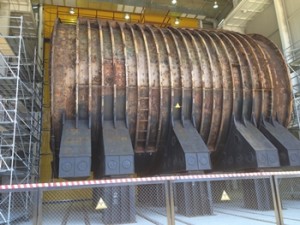 |
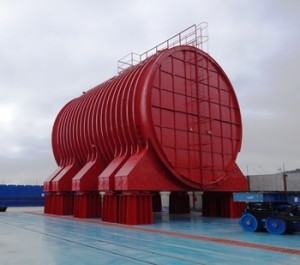 |
| Before painted | After painted |